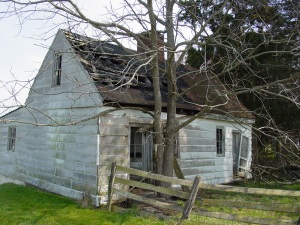

Four months after his first wife passed away, John started to court Julia Gardiner who was 30 years his junior. They were married the next year, April 1844, in a near-elopement style wedding making John Tyler the first president to marry while in office. There were many eyebrows raised because of the age difference. John Tyler had children older than his new bride! But there is nothing surviving in any of their correspondence to indicate that they had any issues or hesitations based on the age difference. They were very affectionate and loving to each other and went on to have seven children.
After their wedding ceremony in New York near her parent's home, John and Julia went on a wedding trip with many stops including his new home Sherwood Forest in Virginia. The author describes the occassion of Julia's first meeting with her newly acquired 60 plus slaves on the plantation. I thought to myself, what was running through her mind as she, a Northern born wealthy woman, was meeting her slaves for the first time? Was this awkward for her? Did she detest slavery and just do what she had to do because she married a southern plantation owner? Or, being from a very wealthy family, was she used to someone else doing the work and what did it matter if they were called slaves or servants?
 |
| An old duplex slave cabin on Sherwood Forest Plantation |
The author must have read my mind. He answered that very question in the next chapter of the book which describes the Gardiner family. Lion Gardiner came to America in 1635 with the Connecticut Company to protect the settlement from Indians, first by killing them and then Lion sought another way by seeking to understand and communicate with them. For ten pieces of cloth he purchased Manchonake Island off the coast of Long Island and continuted to buy more and more real estate on Long Island. Those purchases stayed in the family and made them wealthy. Manchonake Island is now Gardiner Island and is still owned by the family today. The Island was passed down through the generations until 1816 when Julia's father, David, became its caretaker while its rightful heir was only 12 years old. The farming on Gardiner Island was worked by Indian and African slaves from Lion Gardiner's time until 1817 when New York manumitted its slaves! I was shocked! I have never heard of slavery above the Mason-Dixon line!
But this answered my question about Julia's state of mind while looking over the slaves of Sherwood. Slavery was not foriegn for her. Although slaves were manumitted before she was born in New York, her family must not have objected. It was their way of life for almost two hundred years. Maybe they were even bitter that they lost their work force! The author quotes the New York Herald who, in 1844, called Julia a "Northern Bride with Southern Principles" drawing attention to the similarities in her family's way of life to those of the southern plantation owners.
Now I am very curious about slavery in the north. How many other Northern states freed their slaves before the Civil War? Who else in New York had slaves? Why were they freed in 1817? Who on the state level worked that legislation through and why?
 |
| Gardiner Island Manor House built in 1947 |
And also, who will go with me to go visit Gardiner Island??
